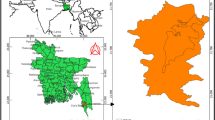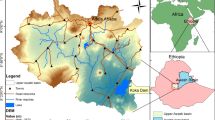Abstract
Several parameters are combined to form a system; if one of the parameters is changed, it also influences the other parameters. Both biophysical components and features made by humans are dynamic and constantly changing. Resources are being used to rapidly meet the growing population demand, causing changes in land use and land cover (LULC). It is believed that LULC change is a significant component of global change that impacts climate change. A significant amount of effort has been into creating methods for remotely sensed data change detection. LULC change detection of Hyderabad using remote sensed images has been performed in this project. Landsat 7 ETM+ imagery for 19 May 2000 and Landsat 8 (OLI/TIRS) imagery for 5 May 2015 has been obtained from the USGS Earth Explorer. ERDAS Imagine 9.1 is used for image rectification, layer stacking, and cloud cover correction. A spectral signature training file is prepared using the pixel values of the image and its properties in the ArcGIS 10.1. Then, the supervised classification was done using the maximum likelihood classifier in 4 different classes (Class 1: Vegetation, Class 2: Barren land, Class 3: Waterbody, and Class 4: Built-up). Post-classification comparison of the two maps is made on a pixel-by-pixel basis using a change detection matrix. Moreover, the changes from the before image (19 May 2000) and after image (5 May 2015) have been done in Arc GIS 10.1 using raster calculator with the image difference method (Before and After images) and ERDAS Imagine 9.1 using the Change Detection tool. ERDAS Imagine 9.1 performed better than ArcGIS 10.1 and shown distinct changes. From the LULC change map, great changes in the stretch of water body have been observed from 2000 to 2015. The different classes of the before map have been merged into other classes or changed as new classes in the after map. The area under the water body has been transformed into a built-up area and barren land. LULC change in 15 years also induced two new classes in the study area Class 1 and Class 2. The observed new classes and to distinguish this class from other classes ground survey has been done using Google Earth. In ground survey, the Class 1 has been identified as Nehru zoological park and Class 2 as a planned residential society. LULC change map can be used by the government, decision-makers, and policymakers and can help in proper resource management and policymaking.
Access this chapter
Tax calculation will be finalised at checkout
Purchases are for personal use only
Similar content being viewed by others
References
Barker K (2006) Barker review of land use planning: final report, recommendations. The Stationery Office
Bayarsaikhan U, Boldgiv B, Kim K, Park K, Lee D (2009) Change detection and classification of land cover at Hustai National Park in Mongolia. Int J Appl Earth Obs Geoinf 11(4):273–280
Bisht DS, Chatterjee C, Raghuwanshi NS, Sridhar V (2018) Spatio-temporal trends of rainfall across Indian river basins. Theoret Appl Climatol 132(1):419–436
CGWB, Central Ground Water Board (2013) Dynamic ground water resources of India. Ministry of Water Resources, Government of India. http://cgwb.gov.in/Documents/Dynamic%20GWRE-2013.pdf
Diallo Y, Hu G, Wen X (2009) Applications of remote sensing in land use/land cover change detection in Puer and Simao Counties, Yunnan Province. J Am Sci
Fan F, Weng Q, Wang Y (2007) Land use and land cover change in Guangzhou, China, from 1998 to 2003, based on Landsat TM/ETM imagery. Sensors 7(7):1323–1342
Irish RR, Barker JL, Goward SN, Arvidson T (2006) Characterization of the Landsat-7 ETM+ automated cloud- cover assessment (ACCA) algorithm. Photogram Eng Remote Sens 72(10):1179–1188. Fno
Jensen JR (2005) Introductory digital image processing: a remote sensing perspective. Pearson Prentice Hall. Upper Saddle River, NJ, 7458, pp 1–131
Kottek M, Grieser J, Beck C, Rudolf B, Rubel F (2006) World map of the Köppen-Geiger climate classification updated
Muttitanon W, Tripathi N (2005) Land use/land cover changes in the coastal zone of Ban Don Bay, Thailand using Landsat 5 TM data. Int J Remote Sens 26
Novelli A, Tarantino E (2015) Combining ad hoc spectral indices based on LANDSAT-8 OLI/TIRS sensor data for the detection of plastic cover
Rawat JS, Kumar M (2015) Monitoring land use/cover change using remote sensing and GIS techniques: a case study of Hawalbagh block, district Almora, Uttarakhand, India. Egypt J Remote Sens Space Sci 18(1):77–84
Roy PS, Roy A (2010) Land use and land cover change in India: a remote sensing and GIS prespective. J Indian Inst Sci 90(4):489–502
Shalaby A, Tateishi R (2007) Remote sensing and GIS for mapping and monitoring land cover and land-use changes in the Northwestern coastal zone of Egypt. Appl Geogr
Singh A (1989) Digital change detection techniques using remotely-sensed data. Int J Remote Sens 10(6):989–1003
Torahi AA, Rai SC (2011) Land cover classification and forest change analysis, using satellite imagery-a case study in Dehdez area of Zagros Mountain in Iran. J Geogr Inf Syst 3(1):1–11. vineyard. Remote Sens Lett 6(12):933–941.
Wicke B, Verweij P, Van Meijl H, Van Vuuren DP, Faaij AP (2012) Indirect land use change: review of existing models and strategies for mitigation. Biofuels 3(1):87–100
Zope PE, Eldho TI, Jothiprakash V (2016) Impacts of land use–land cover change and urbanization on flooding: a case study of Oshiwara River Basin in Mumbai, India. CATENA 145:142–154
Author information
Authors and Affiliations
Corresponding author
Editor information
Editors and Affiliations
Rights and permissions
Copyright information
© 2024 The Author(s), under exclusive license to Springer Nature Singapore Pte Ltd.
About this paper
Cite this paper
Anand, N., Kumari, S., Deshmukh, A. (2024). Comparison of Image Processing Techniques to Identify the Land Use/Land Cover Changes in the Indian Semi-arid Region. In: Patel, D., Kim, B., Han, D. (eds) Innovation in Smart and Sustainable Infrastructure. ISSI 2022. Lecture Notes in Civil Engineering, vol 364. Springer, Singapore. https://doi.org/10.1007/978-981-99-3557-4_4
Download citation
DOI: https://doi.org/10.1007/978-981-99-3557-4_4
Published:
Publisher Name: Springer, Singapore
Print ISBN: 978-981-99-3556-7
Online ISBN: 978-981-99-3557-4
eBook Packages: EngineeringEngineering (R0)




